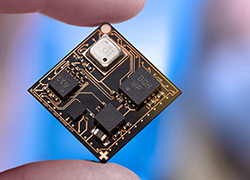Newsletter 02/2021
In collaboration with Globalfoundries Dresden, an alliance of Fraunhofer Institutes in Saxony has developed a sensor platform that can be used to create individually configurable IoT and edge computing solutions. For small and medium-sized enterprises, the platform represents an unprecedented opportunity to cost-effectively produce exceptionally powerful, energy-efficient, and highly integrated systems. Compared to in-house development, this approach offers substantial savings in terms of time and development costs.

How can we develop a highly integrated multichannel sensor solution for mechanical engineering? Or a networked sensor system for building automation? Needs-based, miniaturized development of smart systems tailored to individual specifications is a time-consuming and expensive business for small and medium-sized enterprises (SMEs): Off-the-shelf electronics assemblies are not an option, so they have to develop innovative system solutions for selected clients themselves, mostly in limited quantities.
“Increasingly, clients expect highly integrated electronics prototypes or small production runs for the Internet of Things (IoT) and edge computing. Without the corresponding system architectures and manufacturing methods, however, it is very difficult for SMEs to secure a return on their investment in development,” says Dr. Peter Schneider, Head of the Fraunhofer IIS Division Engineering of Adaptive Systems EAS in Dresden.
Helping SMEs drive innovation
Under the coordination of the EAS division, a consortium of Fraunhofer institutes and industry partners developed the “Universal Sensor Platform USeP.” The system gives SMEs in particular access to a variety of modular and configurable platform elements which they can combine thanks to a highly flexible building-block approach. “The 3D sensor platform allows developers extensive freedom in terms of both software and hardware to create leading-edge customized products. Whereas to date this would generally involve a price tag of hundreds of thousands of euros or more, in some cases SMEs can now save up to 90 percent of the associated time and costs,” Schneider explains. Thanks to the productive and intensive collaboration between the participating development partners, the groundbreaking project was brought to a successful conclusion in just three years. Furthermore, USeP has already passed its first practical test: In a collaboration involving Globalfoundries Dresden and five other hardware and software companies, it formed the centerpiece of an edge AI pilot solution. The platform helped the companies to develop a minimum viable product for predictive maintenance of ultrapure water valves in chip production.
Building blocks for high-tech development
“The sensor platform based on the GLOBALFOUNDRIES 22FDX® technology developed in Dresden allows an energy-efficient yet extremely powerful SoC (System on a Chip) design with embedded MRAM making it suitable for highly demanding edge computing applications,” says Dr. Axel Preuße of Globalfoundries Dresden. The chip features numerous wireless and wired communication interfaces, and employs a powerful 32-bit RISC-V processor with 9 cores in total as its central computing and control unit. This open-source processor architecture is considered groundbreaking, not least in light of its openness and flexibility, and offers an ideal basis for secure and reliable electronics. Another distinctive feature of the platform’s unique system architecture is its combination of cutting-edge assembly and packaging technologies with the latest semiconductor design methodologies and security components. The flexible building blocks and associated software environment allow straightforward integration of a variety of sensors.
The research project, which was funded by the Free State of Saxony and the European Union’s European Regional Development Fund (ERDF) is already complete, and has given rise to an independent company: Aside from enabling its clients to customize highly integrated sensor electronics modules with the help of the Universal Sensor Platform, the startup Sensry in Dresden also acts as a mediator for SMEs interested in leveraging the expertise of the USeP development partners. As a result, they have access to a supply chain they can rely on to efficiently bring their ideas and visions to life, with comprehensive long-term support for concept development, system design, processors, sensors, and data transmission, as well as simulation and testing of their planned systems.
The Universal Sensor Platform (USeP) was developed in collaboration between Globalfoundries Dresden and the Fraunhofer Institute for Photonic Microsystems IPMS, the Fraunhofer Institute for Electronic Nanosystems ENAS, the Fraunhofer IZM Division All Silicon System Integration ASSID, and the Fraunhofer IIS Division Engineering of Adaptive Systems EAS. The research partners are supported by colleagues from Fraunhofer IZM in Berlin, Fraunhofer IIS in Erlangen, and Fraunhofer AISEC in Garching near Munich.
 Fraunhofer Institute for Integrated Circuits IIS, Division Engineering of Adaptive Systems
Fraunhofer Institute for Integrated Circuits IIS, Division Engineering of Adaptive Systems